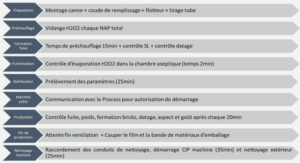Consumerism and counterculture: A study of on the road by jack Kerouac
The development of services and the consumerist society
The industrialization of America began with the mechanization of textile production but was increased by the event of railroads as demonstrated in the previous chapter. In industrial society, the primary activity of labors consisted of the production of goods made increasingly efficient by an elite class of scientist and engineers whose technological innovation led to the increased mechanization and systematization of the production and the division of labor in tasks performed by semiskilled laborers. It is noticed that the rapid urbanization in the Northeast and Great Lakes was made possible by the creation of job for semiskilled laborers and the mass migration to factories. After the turn of the twentieth, the application of the principles of scientific management added the efficiency of manufacturing but also broke down each labor process into component motions and rigorous ordered these fragmented. The influence of the most famous practitioner automobile manufacturer Henry Ford on these principles developed over several decades was very important. Henry Ford was also famous with vision, his explicit recognition that mass production meant mass consumption, a new system of production of labor power, a new political of labor control and management, a new aesthetic and psychology, in a term a new kind of rationalized, modernist society. Henry Ford succeeded in reducing the workday to eight hours and paid his workers a generous five dollars a day thereby providing them with both the time and the disposable income to become consumers of the very goods they were producing. At the end, this created greater demand for consumer goods which in turn led to increased production for which more labor power was needed to keep with the demand, which created 12 more consumers etc… Henry’s model will be used as a model for economic growth in industrial America and by this way helped initiate the culture of consumerism that continues to be a defining characteristic of American culture Consumerism is defined as the belief that personal well-being and happiness depend to a very large extent on the level of personal consumption, particularly on the purchase of material goods. The idea is simply that well-being depends upon a standard of living above some threshold; but that at the center of happiness is consumption and material possessions. A consumerist society is one in which people devoted a great deal of time, energy, resources and thought to “consuming”. The general view of life in a consumerist society is consumption is good, and more consumption is even better.4 A consumerist society is thus the one that insists upon the materialistic possessions to the extent of forgetting other values of a society. It cannot be denied that the roots of consumerism lie in the 18th century. Before the 18th 4 Consumerism and consumption, Norton August 13 century, several factors held consumerism at bay. The increasing of demand was noticed with the discovery of products such as sugar, a variety of spices, colorful dyes, the availability of products such as high fashion clothing but this concerned the wealthier class of individuals that could afford these products. During the time period between 1800 and 1920, a number of important events in the development of consumerism occurred. By 1850, large department stores had spread to the other major cities in the United States. In addition to that, mail order catalogs began to appear and the first advertising agencies were born. A wide variety of imports and consumer goods became available. These developments associated with a number of changes in the psychology profile of society, set the stage for the explosion of consumerism that would begin in the 1920. While the origins of mass production were rooted in early part of the century, it was until the post-world war II that consumerism began to find a firm foothold in American culture. The years leading to World War II were difficult economic times for the country. The great depression put the development of on hold for a short period of time. However, the economic engines required to support the war effort were just what the business community needed in order to reignite the economy. Attempts to mask consumption in patriotic terms positioned consumerism as a citizen’s civic duty. An observation of Lizabeth Cohen will insist on the fact that Mass consumption in post-war America would not be a personal indulgence, but rather a civic responsibility designed to 14 provide full employment and improved living standards for the rest of the nation5 It was also noticed that during and after World War II, workers moved to urban areas in order to pursue work and consequently there was a loss of family, community and the traditions as a result to an empty self. But what was important was that America was prospering, the economy was booming, people have enough time and money to buy the consumer goods made available by the new techniques of the industries. Advertisements such as television, radio available in any house as a necessary item in post-war consumerist America also initiates consumerism as it shows to Americans the ideal family, one that owes material appliances. Another important thing noticed is that as consumerism flourishes, it helps to create the suburban lifestyle of White-middle class and further a climate of consensus and conformity. To many, the post-war period and precisely the fifties represent the fulfillment of the American dream in terms of its association with material abundance and affluence. In a term, people in the consumerist society buy goods they don’t necessary need in order to show their social status. This shows the extravaganza of post-war era as the result of the economic development of a country after a bloody war and all people are ready to do in order to forget about it. 5 Lizabeth, Cohen, A Consumer’s republic: The politics of mass consumption in postwar America, p 113 15 C- Response to the extravaganza of the era America thus experienced an economic growth in the aftermath of World War II with the increasing of its industries. With the end of this bloody war, people wanted to get rid of all the negative aspects they experienced during these difficult moments. People started to testify all the material products available to them such as the automobile, the television sets to name but a few. Their dream of a successful life was defined in term of material possessions. An important phenomenon was also noticed, that a growing number of people moving to Suburban areas already mentioned above. The migration out of the cities was led by young married couples seeking better living conditions of raising their families. This movement strengthened the trend toward a more widespread ownership of homes. All over the nation people who could afford to do were moving out of the older cities into the suburbs. Nevertheless, not all people were interested in this pursuit of a better life full of material possessions. Counter movement resisted those tendencies and instead developed alternative attitudes towards this consumerist society. This group was called the Beat Generation or Beatniks. They can be described as the one succeeding the Lost Generation focusing on the first copies of On the Road A group of rebellious Americans had risen after World War I and called themselves the Lost Generation (…) and now another group had emerged from World War II, and was 16 roaming America in a wild, desperate search for purpose, this was the Beat Generation6 Jack Kerouac embodied in this way the bohemian of the fifties who revolted against what he considered a barren society. He expressed the values of life, one which is experimental as it was full of sex, drugs, alcohol and adventure. Kerouac was born in Lowell, a small manufacturing town in Massachusetts, on 12th of March 1922 in a French family from Quebec. It is asserted that he lived in poor conditions during his childhood. Kerouac’s interest in writing grew stronger having written several articles for the school’s literary Magazine. 1950 marked the starting of his career as a writer but also the publication of his first work, The Town and the City, an autobiographical novel putting emphasis on his struggle to combine his success on the University football team and his problems at home. He realized after that what he really wanted to do is to spend his life as a writer. This aim was clearly expressed in Vanity of Duluoz published in 1968 A life of writing about what I’d seen with my own eyes, told in my own words, according to the style I decided on at whether twenty one years old or thirty or forty or whatever late age, and put it all together as a contemporary history record for the future times to see what really happened and what people really thought7 6 Ellis, Amburn, Subterranean: The hidden life of Jack Kerouac, New York, St Martin’s Press, 1998, p270 7 Jack Kerouac, Vanity of Duluoz, Penguin Books, New York, 1968 17 With the other members of the group namely his friend Allen Ginsberg, William Burroughs, Carr, he formed what was known as the Beat Generation or to use the words of John Clellon Holmes, one of Kerouac’s closest friend, the generation that follows-up the Lost Generation: John Clellon Holmes… and I were sitting around trying to think about the meaning of the Lost Generation and the subsequent existentialism and I said “you know John, this is really a Beat Generation and he leapt up and said, “That’s it, that’s right”8 The term Beat which qualified Kerouac’s generation has many connotations. In the origin, it meant poor, down and out, dead-beat. It can also refer to something spiritual, moral like “beatific”. Putting it in the context of World War II and all its consequences, the term was associated to the effects it had on the members of this generation. The concept can also be defined in the following lines A rallying point for elusive spirit of rebellion of these times, that silent sit down strike of the disaffiliated. The ugliness of American life appeared on every page of On the Road but does not feel it (…) beneath the beatness on the surface of everything; Kerouac finds beatitude” 9 8 Jack Kerouac, Origins of beat Generation, Playboy, 1959, p 90 9 Ellis, Amburn, Subterranean Kerouac, op.cit p 277 18 The generation was formed by writers that rejected the traditional values of America and adopted a hedonistic lifestyle of drugs, alcohol, sex, jazz. They were, like Jack Kerouac said in the Aftermath: the philosophy of the Beat Generation, “crazy illuminated hipsters suddenly rising and roaming America, serious, curious, bumming and hitchhiking everywhere, ragged, beatific, beautiful in an ugly graceful new way” 10. They stood as the Cultural Revolution in progress, the postwar II generation of disaffiliated young people without spiritual values. They decided to write in order to express their confusion and disenchantment about what they wanted from life as for them writing is a passive mean of resistance. Their style was meant to be experimental and non-conformist. To this point, On the Road was characterized as a countercultural novel promoting new values or alternatives to the consumerist society.
On the Road and the concept of movement Jack Kerouac’s
On the Road was based on a series of cross-country trips that Kerouac himself made with Neal Cassidy between 1947 and 1950 at the very moment other Americans were rediscovering the mobility they had lost during the years of depression and wartime. The phenomenon that soon followed up that was an explosion of cars on the road encouraged by the sleek new highways of Eisenhower’s interstate highway system considered as the main achievement of the fifties. Among the books that could be cited as the best sold ones at that time was The Whyte’s the organization Men published in 1956, a novel showing that Americans were becoming rootless people thanks to migration from rural areas to cities, from cities to new towns and suburbs and from manufacturing jobs to corporate white collar positions that transferred them from different parts of the country. The road seemed to be a mean to turn its back to the world of marriage, families and jobs but it had more to do with the new mobility that peace and prosperity afforded to many Americans in the fifties. The jobless, penniless drifters of the depression were turning into the white-collar transients of the post-war world. Kerouac’s protagonists, one rootless, the other restless were pushing their way past a door that was already swinging open. On the Road succeeded in attaching the new restlessness to the classic American mythology of the road and to use it in order to express a set of values namely exuberance, energy, spirituality, intensity, improvisation that would challenge the Suburban and corporate conservatism of the 1950. The road stood as the expansive, footloose spirit of America but also the need to escape from the 21 constraints of the new domesticity and work ethic. Concerning the novel’s hero, he was a combination of James Dean and Sherlock Holmes. He is everything from a charismatic conman to a Holy Goof with the energy of a new kind of American saint. Dean Moriarty’s image was constructed in this way. He is someone who lives for kicks and is so irresponsible to make everyone around him miserable and above all women. He is a self-made man in the difference of Kerouac who was raised on a mother love. He represents in the eyes of Sal Paradise a fleet runner, legendary driver, virtuoso lover in sum everything he is not, comfortable in his own skin, free of moral hang-ups and families ties in the contrary of Sal who never breaks the umbilical cord connecting him to his aunt. He is associated to Huck Finn who was actually born on the road with his wino father in Denver, an abused child and orphan who learned early how to take care of himself. The character Dean Moriarty is seen in On the Road as the demon who presides over the road, he is the tutelary the spirit of the West It is asserted that the American tradition of the road was built on the scale of the continent itself with the frontier and the great open spaces of the West that made endless migration possible. This migration which led to the West was what first brought the colonists to the new World. The Westward movement can be explained focusing in Biblical and Christian imagery and according to it, it is always renovating and apocalyptic, offering the promise of a fresh beginning life. In On the Road as well as in early Westerns for instance the Virginian, the East stands as a state of unhealthy ossified civilization, an indoor civilization not denaturized, while the West represents a new world full of explosive energies and dangerous possibilities. The importance of Road novels and movies was most noticed in the thirties when many Americans were uprooted by the depression. It was the case 22 of I am a fugitive from a chain gang (1932) and Wild Boys of the road (1933) to USA, The grapes of wrath and the Sullivan’s icons of the era, photography and depression journalism as well as film. When we come to Mark Twain, he succeeded in turning the Mississippi River into an escape route that rescues Nigger Jim from slavery and Huck Finn from the brutality of his drunken father. In the end of the novel, Huck decided to light out for the territory when the adults threaten to civilize him. The importance of the road was also noticed in Walt Whitman’s work who took it as the emblem of a truly American freedom. In the same respect, Jack London in his The Road (1907) insisted on the importance of the latter one I became a tramp-well, because of the life that was in me, of the wanderlust in my blood that would let me rest. “ I went on the road, because I couldn’t keep away from it, because I had the price of the railroad fare in my jeans11 He but also Vernacular writers such as Twain, Sherwood, Anderson, Hemingway, Ring Lardner, Nelson Algren and William Saroyan received response from Kerouac who was literary and self-conscious even if they were writers who most impressed him. The fact to go on the road in the novel had most to do with a myth of rebirth as literary and religious parables than with a matter of economic need as it was noticed during the Depression. It is noticed that right from the beginning, the protagonist was inhabited by a feeling of loss when he says “my whole life was a haunted life, the life of the ghost. I was halfway across America, at the dividing line between the East of my youth and the West of my future. This is both a destination and a dream of pure movement, directionless, propulsive and unreflective. Dean’s travels seemed to the eyes of Sal, a conventional person, maniacal and completely meaningless even if at times, he was made ecstatic and projected into the realm of pure spirit by these travels. It is evidenced that Kerouac himself was afraid of driving, of flying, unease with women in the contrary of Dean whose amazing physical dexterity and conman’s irresistible charm allowed him to perform with ease and confidence all this. As Road movies reached their peak at that period, the Life Magazine was mythologizing a rugged son of the West namely Jack Pollock who was harddrinking, taciturn, intensely physical and who often work on a grandiose American scale. He had studied with Thomas Hart Benton but then gone his own way even if the influence of the latter one in his work was of great importance. By rejecting the realism of the thirties muralists, he aimed at creating large, movable pictures that will function between easels and murals. He was able to create a grid, a complex impasto of paint that represented almost a road map all this by keeping the canvas on the floor, throwing paint on it and letting it drip as for Pollock, the canvas itself was his way of being on the road, of taking off an explosive free-form adventure of his own will until he ended killing himself and the wife with him by wrapping his car around a tree. He was in this way a casualty of the road in comparison to Dean Moriarty.
The spiritual alternative and the recourse to drugs
Kerouac’s characters have taken the road to search an alternative lifestyle in the example of the Transcendentalists who believed to the possibility and even the necessity to live for experience. They were trying to find a way to survive in an environment they fight to overcome loss and to get rid of the social conventions; they needed a more satisfying life as they feared to be spirituality corrupted if they stayed in the society. They wanted to be spiritually fulfilled and this is what led them to the road. Ann Charters, in her Introduction to on the road, will clearly say Kerouac’s friends Holmes understood that the characters in on the road were actually on a quest, and that the specific object of the quest was spiritual. Though they rushed back and forth across the country on the slightest pretext gathering kicks along the way their real journey was inward; and if they seemed to trespass most boundaries, legal and moral, it was only in the hope of finding a belief on the other12 This quotation does nothing but evidences the aim of Kerouac’s characters, what they are trying to achieve. Nevertheless, in order to understand the quintessential meaning of the text or the spiritual connection created by the road, one must focus on the relationship between the two protagonists as critics who focused on the religious base of the text did it by analyzing Buddhism in it. As it was already mentioned, Kerouac’s on the road was the result of the meaning coming out of the new highways of post-world war II America With on the road Kerouac caught a novel feeling putting his finger on the pulse of a new post-war American heartbeat of restlessness, discontent juvenility, and most importantly movement, while the beats did not look to the future with utopian vision they nonetheless agreed on the road as site for transformation The road therefore plays a leading role as Sal Paradise relies on movement and imagination to free and renew his wounded spirit. The road takes Kerouac from the spiritual poverty of traditional American life. It is the symbol of America’s true wealth and potential. It is the symbolic expression of all spiritual roads. Kerouac will say “the road is life” (p 175). This shows the true value of his road. The road serves as an escape. It stands as a spiritual path and helps Sal to escape from the heartbreak or the sadness of his past life. I first met Dean not long after my wife and I split up. I had just gotten over a serious illness that I want bother to talk about, except it had something to do with the miserable weary split up and my feeling that everything was dead. With the coming of Dean Moriarty become part of my life that you could call my life on the road (p3) The road is a main way to leave behind the past and to become spiritually fulfilled. But this aim cannot be achieved without the famous Dean Moriarty, the hero of the road born on it but above all Sal Paradise’s spiritual guide. To describe Dean as a spiritual guide will seem odd but he is the one who initiates Sal to the life on the road. He represents all that he is not, the life he badly wants to achieve, his companion travel towards a perfect world. He even compares him to a prophet who lives his life without worrying about anything, he stands as the life beyond reality And his criminality was something that sulked and sheered; it was a wild yea-saying outburst of American joy, it was the western, the west wind, an ode from the plains, something new, long prophesied, long a coming he only stole cars for joys rides. Besides, all my New York friends were in a position of putting down society and 28 giving the tired bookish or the political or psychoanalytical reasons, but Dean just raced in society eager for bred and love. He didn’t care one way or another…a western kinsman of the sun, Dean … I could hear a new call and see a new horizon. Somewhere along the line I knew there’d be girls, visions, everything, smoking along the line the pearl would be handled to me (p101) He teaches Sal how to get the most out of the moment. With his incapacity to get a perfect world, he tries to gain fulfillment trough a figure that he is full of life and energy. Sal Paradise has always been moving in order to reach his perfect world. The novel tackles Sal Paradise’s spiritual and physical journey between the East and the West as already mentioned. The West which represents his future will as far as he is concerned free him and stands as the embodiment of joy and all that is free I heard a great laugh, the greatest laugh in the world and here came this rawhide oldtimer Nebraska farmer with a bunch of the other boys into the diner…everyone else laughed with him. He didn’t have a care in the way and had the hugest regard for everybody. I said to myself wham, listen to that man laugh. That’s the West, here I am 29 sitting right next to me. I am in the west…it was the spirit of the west sitting right next to me. I wish I knew his whole raw life and what the hell he’d been doing all these years besides laughing and yelling like that (p 21) The West can be the right place to reborn without all what he already experienced in his life. Dean Moriarty is thus Sal’s spiritual guide “the ghost of the sidewalk” and he acts like that when he asks him “what’s your road, man holy boy road, mad man road, rainbow road for anybody”. Anyhow. Where body now” (p251). This shows the importance of the road that must be taken to complete the spiritual search. He wants to heal emotional wounds by finding a way to a world without all the imperfection of the cruel world. He feels beaten down by the superficial ways of the modern life. He describes in one passage his viewed of tortured soul in this modern life Suddenly I found myself on Times Square…and right in the middle of a rush hour, too, seeing with my innocent roadeyes the absolute madness and fantastic hoorair of the New York with its millions and millions hustling forever for a buck among themselves, the mad-dream, grabbing, taking, giving, sighing, dying, just so they 30 could be buried in those awful cemetery cities beyond Long Island (p106) Sal Paradise is trying to reach what he aims at but this seems difficult which offers no assistance. For him, imagination is the only way he gets to find out relief. Fantasy is what guided him and he views Dean as the prophet who has come to guide him to “It”. He aims at closing this difficult chapter of his life. With the coming of Dean, he sees a chance for renewal but the journey was not easy as expressed in the following lines Doesn’t it true that you start your life a sweet child believe in everything under your father’s roof? Then comes the day of the lacideans, when you know you are wretched and miserable and poor and blind and naked and with the visage of a grieving ghost you go shuddering through nightmare life (p105) Another important thing is the use of drugs that fuelled Jack Kerouac’s characters. These substances they used were taken as another mean to spiritual attainment. The use of drugs was something very common in many writers using them to awaken their creative spirit. It is evidenced that Jack Kerouac used them 31 while writing his novel. Another member of the Beat Generation namely Allen Ginsberg used a number of different drugs because for him, they helped in expanding his consciousness but also gave him the capacity to write a great deal of books under their influence. This is perhaps a main reason in understanding the context and purpose of the presence of drug use in Kerouac’s on the road. The Beat Generation used different kind of drugs in addition to alcohol. They used Marijuana, Benzedrine and rarely opiates for insistence morphine. It is also noticed that they started using psychedelic drugs such as peyote and LSD. These drugs were taken because they were experimental or were just a pursuit of hedonistic desire. The consequences of the drug use were not mentioned but they were taken because they increased or improved creativity. In this case, the use of drugs can be linked to intellectual aspects. The first purpose of drug use was medical. Those who first used Benzedrine nevertheless discovered a stimulant effect. Because of its stimulant effect side, physicians discovered consequently that amphetamines could also be used to treat narcolepsy. This phenomenon increased the production of Benzedrine. Doctors used it to make patients cheerful. As time progressed, people discovered other effects of drugs different from their medical purposes. Armed forces during World War II and the Vietnam conflict used Benzedrine as a stimulant. Many writers consequently used them to encourage their creative spirit. This survey was important to understand the first role of drugs and all they have to become a mean of creativity. The effect that drugs had on Dean Moriarty attracted a lot Sal Paradise who in his turn used them to become like him. The presence of Old Bull is also of great importance as he was the biggest consumer drugs in the group and Dean’s master, knowledge and drug use are therefore linked. Drug is a basis to 32 spiritual knowledge. Achieving spiritual knowledge becomes a spiritual process. Sal Paradise and Dean Moriarty are two persons linked by a spiritual relationship. It is important to mention that on the road is an autobiographical novel and that all the events mentioned on it were real facts. Old Bull Lee who personified wisdom and drug use is in reality William Burroughs, one of the member of this Beat Generation and author of Naked Lunch. The importance of drugs in Kerouac’s search of spirituality is thus relevant. Dope helps him to see visions and God. The characters in on the road use them to experience all they can out of life.
Dedication |






